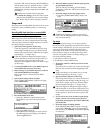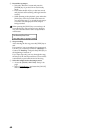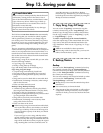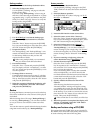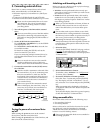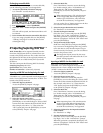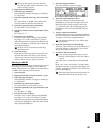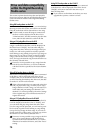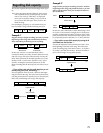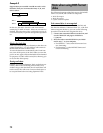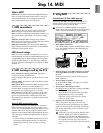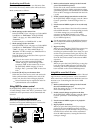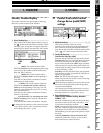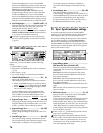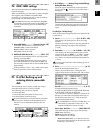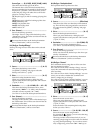
71
This section explains how the D12 manages disk capac-
ity.
It is not necessary that the Optimize Track opera-
tion explained here be used frequently. It is suffi-
cient to use it only if “Disk Busy” is displayed
when you are actually editing, or if you wish to
recover more disk free space after you have fin-
ished the song.
For explanatory purposes, we will assume that you
have recorded a song with the following structure.
Example 1
Suppose that you began recording on track 1 from the
beginning of the song, and recorded only the Intro,
Solo, and Ending as the first pass of recording.
In this case, sections A, B, and the Break will be
recorded as silence (in reality, sound at the noise level),
and will occupy disk space unnecessarily. Execute the
Erase Track operation on the silent portions (A, B, and
Break) of track 1. At this time, the D12 is only “provi-
sionally” erasing the unwanted portions A, B, and
Break, meaning that the disk capacity will not be recov-
ered.
→ If you wish to retain only the audio data that you are
actually using (Intro, Solo, and Ending)……
Execute Optimize Track on track 1 between the begin-
ning and end of the song. This will create audio data for
only the portions that are actually used, so that only the
Intro, Solo, and Ending will occupy disk capacity.
Example 2
Suppose that you began recording on track 1 from the
beginning of the song, and played the Intro, A, B, and
Solo as the first take. Then you recorded A’ and B’ as
the second take.
In this case, the A and B (take 1) data underlying A’ and
B’ of track 1 will remain as a single piece of audio data
together with the Intro and Solo, in order to allow Undo
to be performed. This means that the disk capacity will
be occupied by data for the Intro, A+A’, B+B’, and Solo.
→ If you wish to recover disk capacity by erasing the A
and B data from the first take……
Execute the Optimize Track command on track 1 from
the beginning to the end of the song. This will create
audio consisting only of the Intro of take 1, A’ of take 2,
B’ of take 2, and the Solo of take 1. Sections A and B of
take 1 will no longer occupy disk capacity.
Regarding disk capacity
Intro A B BreakSolo Ending
IN OUT IN OUT
Intro
silence
silence Solo Ending
“EraseTrack”“EraseTrack”
IN OUT
Intro
data
exists
data exists Solo Ending
“OptimizeTrack”
Intro Solo Ending
data
erased
data erased
after execution
Take 1
Take 1
Take 2
Record take 2
Intro
BA Solo
Intro
BA
B'A'
Solo
“OptimizeTrack”
IN OUT
Intro
BA
B'A'
Solo
Intro
B'A'
Solo
Basic operation
Saving your data



